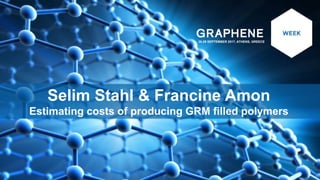Graphene week presentation lcc
- 1. 25-29 SEPTEMBER 2017, ATHENS, GREECE Selim Stahl & Francine Amon Estimating costs of producing GRM filled polymers
- 2. Polygraph EU project scope: Up-Scaled Production of Graphene Reinforced Thermosetting Polymers for Composite, Coating and Adhesive Applications This project has received funding from the European UnionŌĆÖs Seventh Framework Programme for research, technological development and demonstration under grant agreement no 604143
- 3. Coating System Case 1: Few layers pristine graphene + Epoxy resin Case 2: Synthetic graphite + Epoxy resin + Mixing & Exfoliation in-situ Reference: Epoxy resin + Carbon Fiber (CF)
- 5. Adhesive System Case 1: Few layers pristine graphene + Epoxy resin Case 2: Expanded graphite + Epoxy resin + Mixing & Exfoliation in-situ Reference: Epoxy resin + CF
- 7. Composite System Case 1: Pristine graphene nanoplatelets + Epoxy resin + Glass fiber (GF) Case 2: Expanded graphite + Epoxy resin + Mixing & Exfoliation in-situ + GF Reference: Automotive grade steel
- 9. Exfoliation & Dispersion: Netzsch Omega 500 Mixing & Exfoliation System Mixing: Ytron-Y
- 10. Life Cycle Costing for formulation LCC= ØæĪ=0 Øæø ØÉČØæĪ/(1 + Øææ)^t LCC = Total LCC in present-value euros of a given formulation Ct = Sum of all relevant costs occurring in year t N = Number of years in the study period d = Discount rate used to adjust cash flows to present value
- 11. Relevant costs for the formulations Equipment investments Equipment Operating Expenses Materials Costs
- 12. LCC GRM Coating formulation (Ōé¼/kg) Case 1: Pristine Graphene + Epoxy Case 2: Exfoliated Graphite + Epoxy 3: Reference Epoxy + CF
- 13. LCC GRM Adhesive formulation (Ōé¼/kg) Case 1: Pristine Graphene + Epoxy Case 2: Exfoliated Graphite + Epoxy 3: Reference Epoxy + CF
- 14. LCC GRM Composite formulation (Ōé¼/kg) Case 1: Pristine Graphene + Epoxy + GF Case 2: Exfoliated Graphite + Epoxy + GF 3: Reference Steel
- 15. Conclusions ŌĆ£In-situ" production of graphene from graphite within resins is ŌĆō sometimes ŌĆō cheaper. GRM Coating formulations show important savings potential with in-situ process. Life Cycle Costing could be interesting for other GRM/nano formulations.
- 16. ŌĆó Mycenae: Polygraph project result Thursday 15:00 ŌĆó Olympia A: Thursday 16:40 Parallel Session I
- 17. Extras
Editor's Notes
- #3: Scale: 23.5 tonne per year of GRM formulation
- #4: Case 1: Few layers pristine graphene (Avanzare) + Epoxy resin (HMG) Case 2: Synthetic graphite(Imerys) + Epoxy resin (Robnor) + Mixing & Exfoliation (Ytron, Netszche)
- #6: Case 1: Few layers pristine graphene (Avanzare) + Epoxy resin (Robnor) Case 2: Expanded graphite (Imerys) + Epoxy resin (Robnor) + Mixing & Exfoliation
- #10: TRM optional and modelled
- #13: High carbon loading
- #14: Low medium carbon loading
- #15: Low carbon loading
- #16: The development of manufacturing processes by which graphene can be produced and dispersed "in-situ" within thermosetting polymer resins makes sense from an LCC perspective as it seems to be sometimes cheaper than buying and mixing graphene. However, though it may look like GRM Coating formulations are the most attractive for such in-situ processes from an LCC perspective, case-by-case LCC studies are needed to ensure the attractiveness of such processes. Coating: savings for the in-situ comes mostly from the material cost that are greatly reduced due to the fact that graphite is the feedstock (same carbon loading in case 1 & 2) Adhesive: the savings are not as big since there is a need of higher graphite carbon loading than the pristine graphene to achieve the same functionality Composite: same here the in-situ production needs more graphite that the graphene needed in Case 1. And steel is so much cheaper than composite This LCC gives valuable estimation for coating, adhesive and composite producers to see what is the additional cost of including graphene in their formulation and what could be the best way to do it between buying pure graphene and mixing it or trying to produce graphene in-situ.




















